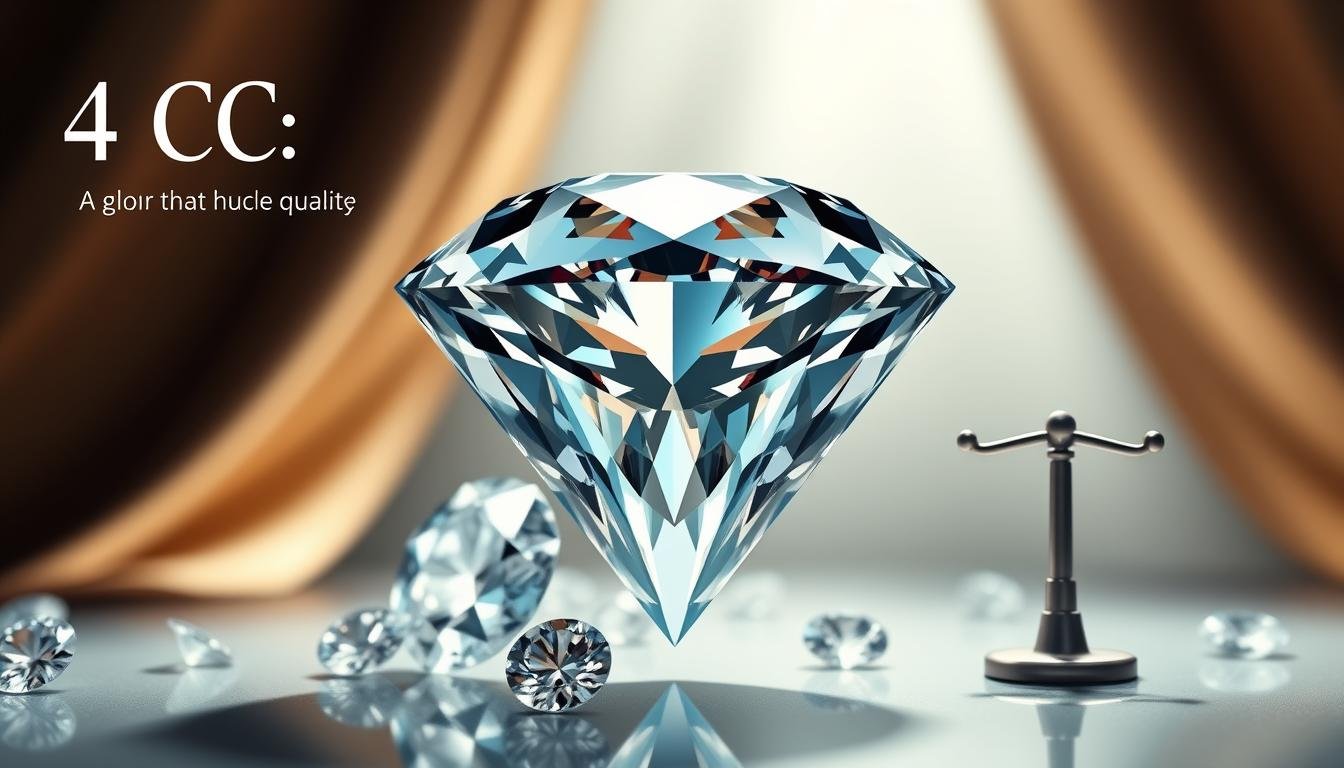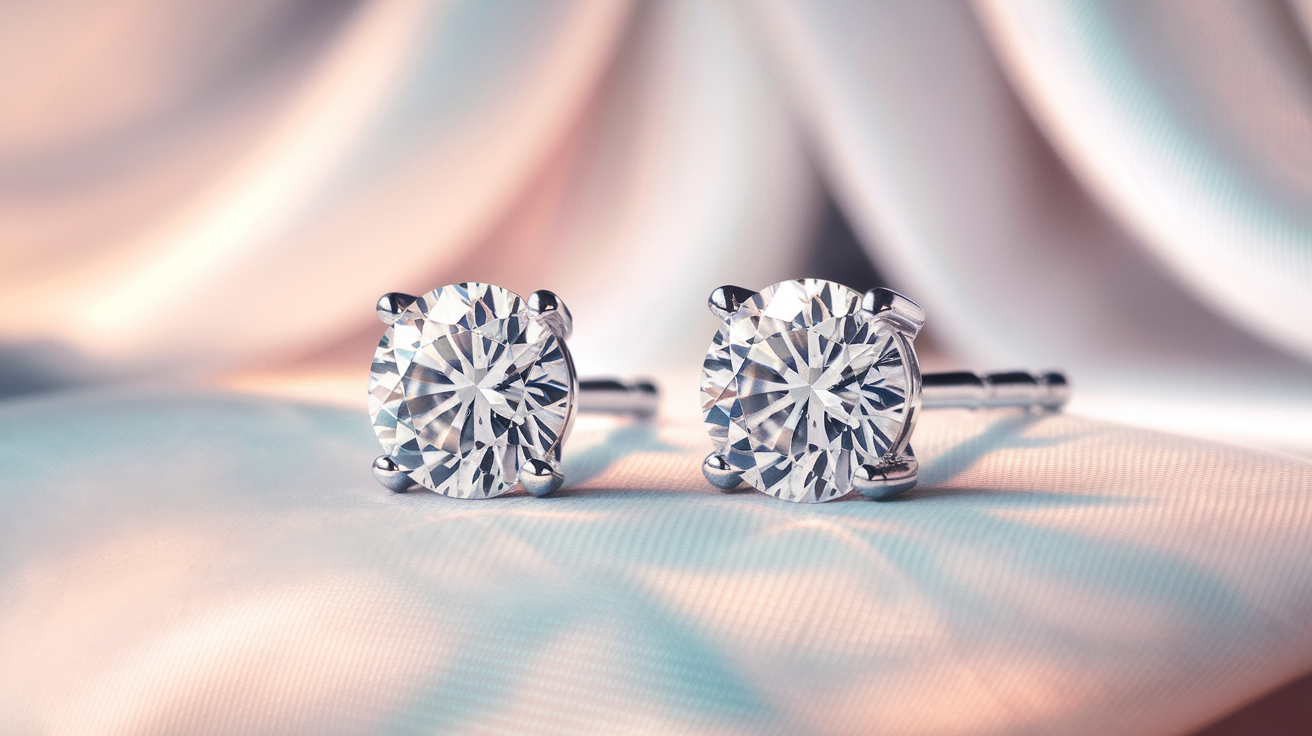In the world of diamonds, the four C’s – cut, color, clarity, and carat weight – are key. They decide a diamond’s quality and value. These stones are a symbol of love and commitment. Knowing the 4 C’s is important for a smart diamond buy.
This guide explores each factor in detail. It helps you confidently shop for diamonds. You’ll find the perfect gem that matches your heart’s wish.
Key Takeaways
- The four C’s – cut, color, clarity, and carat weight – are the industry standards that determine diamond quality and value.
- Cut quality is the most important factor, as it directly impacts a diamond’s brilliance and sparkle.
- Diamond color ranges from colorless (D) to light yellow (Z), with the rarer, colorless diamonds commanding higher prices.
- Clarity refers to the presence and visibility of natural characteristics within the diamond, with flawless stones being the most valuable.
- Carat weight represents the physical size of the diamond, with larger stones typically costing more per carat.
- Careful consideration of the 4 C’s can help you find the perfect diamond that aligns with your budget and preferences.
- Utilizing diamond certification and working with reputable jewelers are key to ensuring a reliable and satisfactory purchase.
Understanding the Importance of Diamond Quality Standards
In the world of fine jewelry, a diamond’s quality is key. It affects its value and beauty. The Gemological Institute of America (GIA) leads in diamond grading. They have a system called the diamond grading that everyone recognizes.
The Role of GIA in Diamond Grading
The GIA grades diamonds based on the 4Cs: cut, color, clarity, and carat weight. This detailed check helps buyers make smart choices. They can compare different diamonds and choose wisely based on what they like and can afford.
Why Diamond Quality Matters for Value
The quality of a diamond, as graded by the GIA, is very important. Diamonds with higher grades in the 4Cs are rarer and more sought after. This means they cost more. Knowing about these standards helps both buyers and sellers make good choices.
“The GIA’s diamond grading system is the global standard for evaluating diamond quality, ensuring transparency and trust in the jewelry industry.”
Learning about diamond grading helps buyers find the right diamond. It fits their taste and budget. This knowledge also helps professionals offer top-notch service and quality products.
The History Behind the 4 C’s of Diamond Quality
The precious gemstones industry has always valued standardized diamond grading. The 4 C’s system is a result of a long history of innovation and teamwork. The Gemological Institute of America (GIA) led this effort, setting the global standard for diamond quality.
The 4 C’s started in the early 20th century. Gemologists then needed a better way to evaluate precious gemstones. In the 1940s, the GIA created a system that looked at a diamond’s Cut, Color, Clarity, and Carat weight. This was the start of the 4 C’s we know today.
Over time, the 4 C’s system has gotten better and more detailed. The GIA keeps updating its standards and methods for the highest accuracy. New technology, like computerized imaging and spectroscopy, has made diamond grading even more precise.
The 4 C’s have become a universal language for diamond grading. It helps buyers and sellers make informed choices based on clear, measurable criteria. Knowing the history and importance of the 4 C’s helps gemstone lovers appreciate the craftsmanship and quality in each diamond.
“The 4 C’s have become the global standard for diamond quality, providing a common language that bridges the gap between industry professionals and everyday consumers.”
Diamond Cut: The Key to Brilliance and Sparkle
The cut of a diamond is key to its quality and value. The cut grade shows how well it shines. Knowing about diamond cut helps you choose wisely.
Cut Grades Explained
The Gemological Institute of America (GIA) grades diamond cuts from Excellent to Poor. These grades look at symmetry, proportions, and polish. All these affect how the diamond looks.
How Cut Affects Light Performance
A good cut diamond reflects light well. A bad cut lets light escape, making it less shiny. Knowing this helps you pick the right diamond when buying one.
Popular Diamond Cut Shapes
- Round Brilliant
- Princess
- Cushion
- Oval
- Emerald
- Asscher
- Radiant
Different cuts have unique looks and shine. This gives buyers many choices for their jewelry.
| Cut Grade | Description | Light Performance |
|---|---|---|
| Excellent | Precise and well-proportioned, maximizing brilliance and fire. | Optimal light reflection and refraction, resulting in exceptional sparkle. |
| Very Good | Slight variations in proportion, but still excellent light performance. | Excellent light reflection and refraction, with minimal light leakage. |
| Good | Minor deviations in proportion, but still a well-cut diamond. | Good overall light performance, with some light leakage. |
| Fair | Significant deviations in proportion, resulting in reduced brilliance. | Notable light leakage, diminishing the stone’s overall sparkle. |
| Poor | Poorly proportioned, with significant light leakage and reduced visual appeal. | Substantial light leakage, leading to a dull and lifeless appearance. |
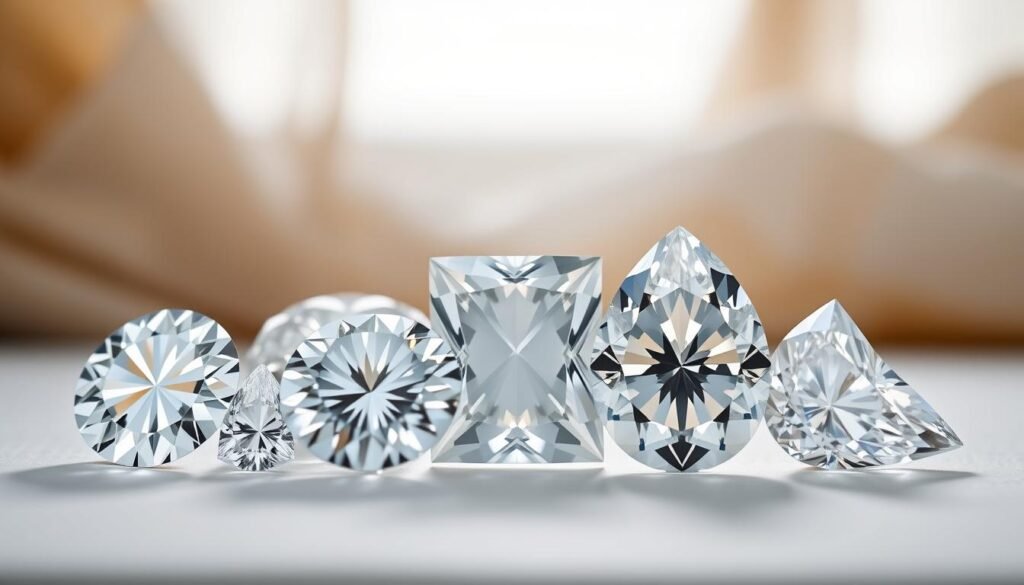
“The cut of a diamond is the most important factor in determining its overall beauty and value.”
Diamond Color: Grading from Colorless to Light Yellow
Color is key when it comes to diamonds. It greatly affects a stone’s value and look. The Gemological Institute of America (GIA) sets a scale from colorless to light yellow.
The GIA’s color grading goes from D (colorless) to Z (light yellow). Each letter shows a slight color change. Diamonds closer to D are more valuable because they are rarer and more sought after. On the other hand, diamonds with a strong yellow tint, near Z, are less valuable.
Even small color changes can make a big difference in a diamond’s look. Colorless diamonds, like D-F, shine like ice. Near-colorless diamonds (G-J) have a hint of yellow that’s hard to see. Diamonds in the faint yellow range (K-M) show a yellow color more clearly. As you move towards S-Z, the yellow becomes more obvious.
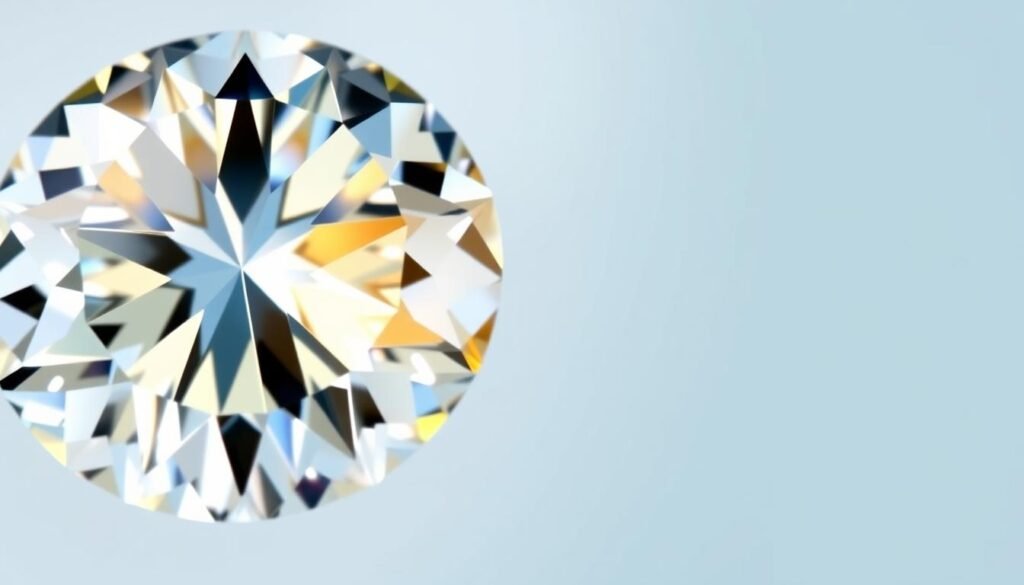
Knowing the diamond color grading scale is crucial. It helps you choose the right diamond within your budget and taste. This way, you find a diamond that truly stands out.
Diamond Clarity: Identifying Natural Characteristics
Understanding diamond clarity is key to knowing a gemstone’s quality and value. Clarity shows the natural flaws inside the stone. These flaws, or inclusions and blemishes, affect the diamond’s shine and worth.
Understanding Inclusions and Blemishes
Inclusions are internal flaws that form during the diamond’s creation. Blemishes are marks on the stone’s surface. These features make each diamond unique and impact its clarity and value.
Clarity Grading Scale Explained
- The clarity of a diamond is graded from Flawless (FL) to Included (I3), with many grades in between.
- Diamonds with fewer and smaller flaws are clearer and more valuable.
- The most valuable diamonds have the highest clarity grades, like Flawless (FL) or Internally Flawless (IF).
Impact of Clarity on Value
The clarity of a diamond greatly affects its value and price. Diamonds with higher clarity grades cost more because they are rarer. Yet, the human eye might not always see the difference between some clarity grades. It’s wise to get expert advice when buying.
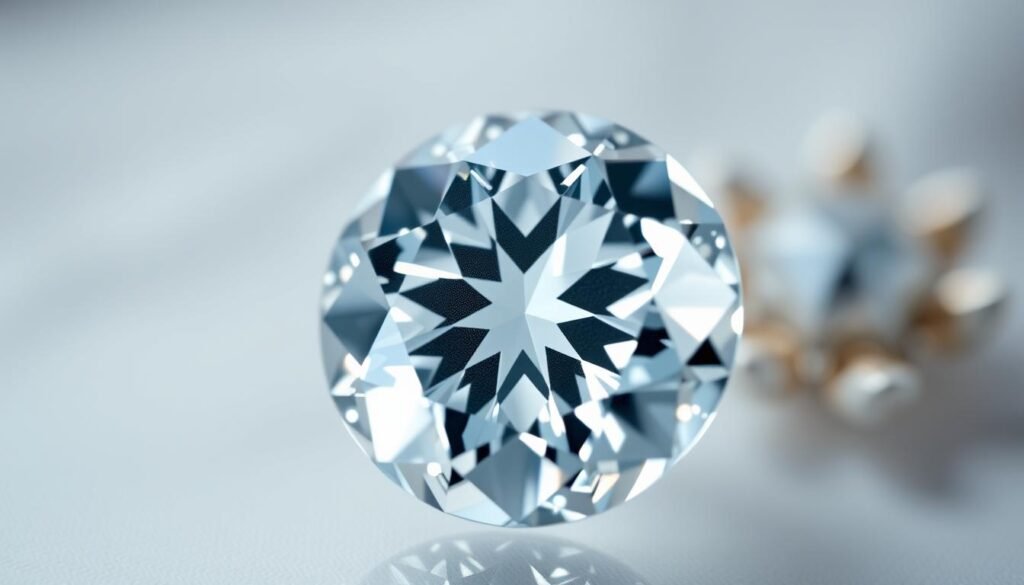
Knowing how clarity affects diamond grading and value helps buyers. It lets them choose the right balance between quality and budget when looking for precious gemstones.
Carat Weight: Size and Value Relationship
Carat weight is key in diamond quality, affecting both value and size. One carat is 0.2 grams. This measurement is used for diamond weight.
Many think bigger diamonds are more valuable. But, the value increase with carat weight is not straightforward. Larger diamonds are rarer, which can make them more expensive per carat.
| Carat Weight | Price Range per Carat |
|---|---|
| 0.5 carat | $1,000 – $3,000 |
| 1 carat | $2,000 – $10,000 |
| 2 carats | $8,000 – $25,000 |
| 3 carats | $15,000 – $50,000 |
Carat weight is just one part of a diamond’s value. The diamond grading system also matters. It looks at cut, color, and clarity. A smaller, well-cut diamond with great clarity and color can be more valuable than a larger, lower-quality precious gemstone.
“When it comes to diamonds, size isn’t everything. Quality should be the priority when selecting the perfect stone.”
Knowing how carat weight affects diamond value helps buyers. They can choose the right size and quality for their budget and needs.
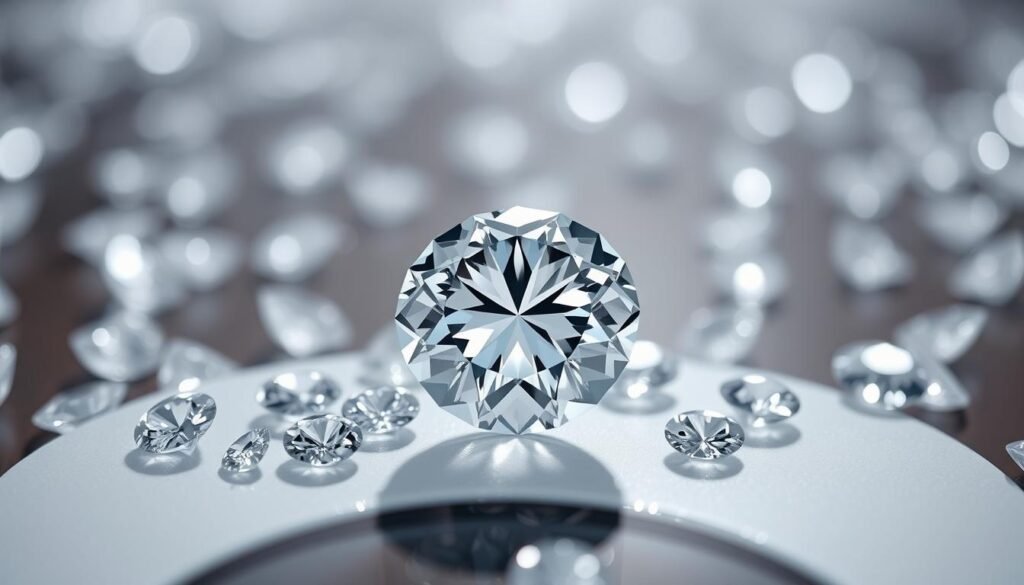
How Diamond Certification Works
When you buy a diamond, knowing its certification is key. Certification checks the diamond’s quality using the 4 C’s: cut, color, clarity, and carat. Gemological institutes like the Gemological Institute of America (GIA) and the American Gem Society (AGS) do this.
Major Certification Bodies
The GIA and AGS are top diamond certification groups. They follow strict standards to grade diamonds. This helps buyers make smart choices.
Reading a Diamond Certificate
A diamond certificate shows a diamond’s quality details. Look at the cut, color, clarity, and carat weight. These tell you the diamond’s quality and value.
| Certification Body | Grading Scales | Reputation and Recognition |
|---|---|---|
| Gemological Institute of America (GIA) | Comprehensive grading system for cut, color, clarity, and carat | Widely considered the global authority on diamond grading and certification |
| American Gem Society (AGS) | Detailed cut grade system, color and clarity grading similar to GIA | Highly respected for its rigorous and impartial diamond grading standards |
Getting a diamond with a good certification is important. It ensures the diamond’s quality and value. Understanding certification helps you choose the right diamond confidently.
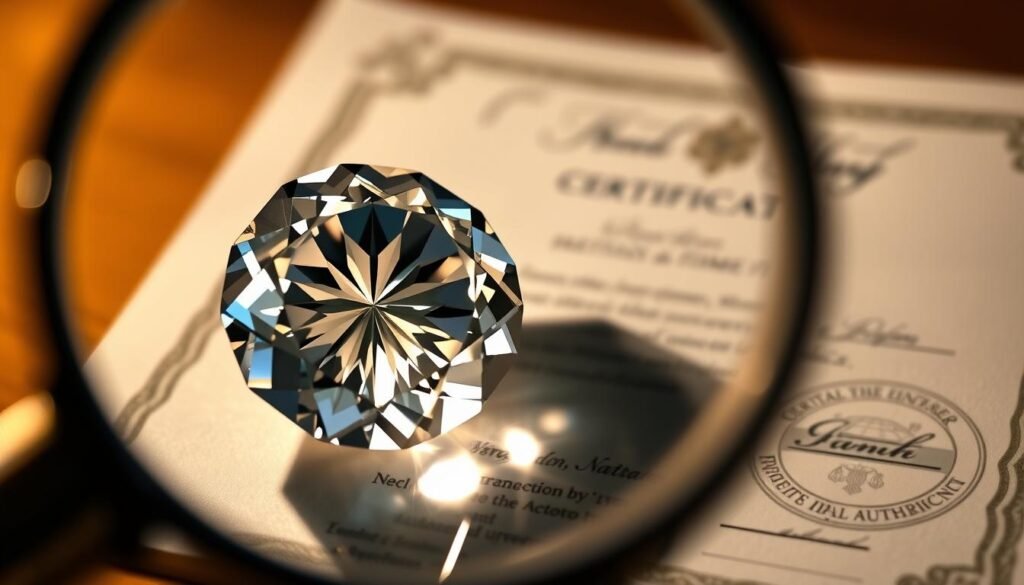
Tips for Choosing the Perfect Diamond
Finding the perfect diamond can seem hard, but knowing the 4 C’s of diamond quality helps. These are cut, color, clarity, and carat weight. With this knowledge, you can choose a diamond that fits your style and budget.
The cut of a diamond is key for its sparkle. A top-notch cut might cost more, but it makes the diamond shine brighter. The color of a diamond is also important. The best are colorless or near-colorless.
- Think about what you want the diamond for, like an engagement ring or jewelry. This helps decide on color and clarity.
- For clarity, pick a grade that’s good but not too expensive. Small flaws might not be seen easily, so you can save money without losing beauty.
- The carat weight affects cost and looks. Balance your budget and what you want to find the right carat size for you.
By looking at the 4 C’s and finding a balance, you can get a diamond that will be loved for years.
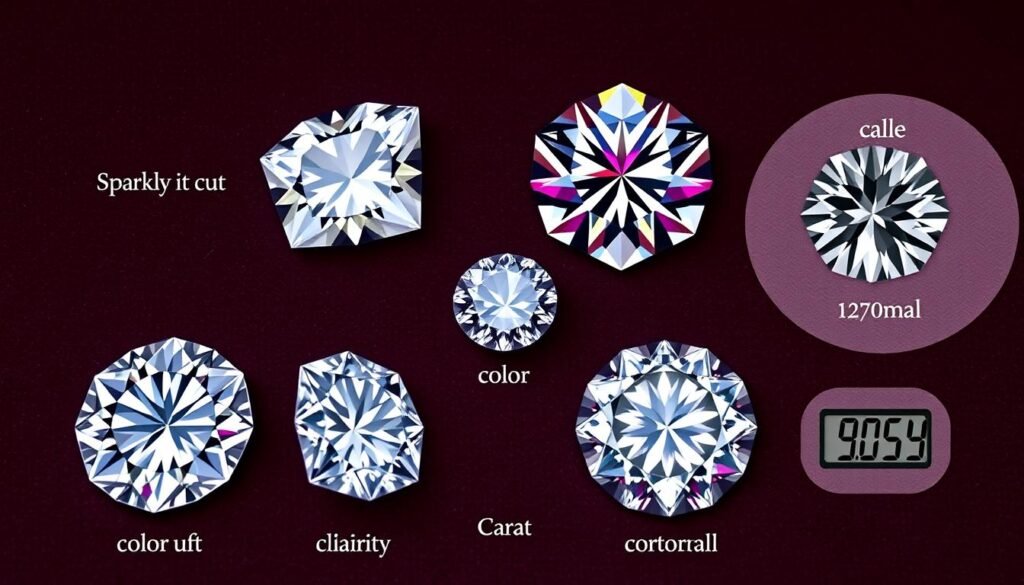
Common Misconceptions About Diamond Quality
Buying diamond grading can be tricky due to many misconceptions. As experts in precious gemstones, we aim to clear up these myths. We’ll give you the facts about the 4 C’s of diamond quality.
Debunking Diamond Myths
Many think the diamond’s price equals its quality. While high-quality diamonds cost more, price isn’t everything. The diamond’s cut, color, clarity, and carat weight also matter a lot.
Some believe smaller diamonds are less valuable. But, a well-cut small diamond can shine brighter than a big, poorly-cut one. The cut grade is key to a diamond’s sparkle and fire.
Price vs. Quality Facts
- A higher price doesn’t always mean better quality.
- Looking at the 4 C’s is crucial for finding quality and value.
- Smaller, expertly-cut diamonds can shine as much as larger ones.
- Certification from places like the Gemological Institute of America (GIA) is key to verifying quality.
Knowing these misconceptions helps you make a better choice. Find the diamond grading that fits your style and budget. Let the 4 C’s of diamond quality lead you to the perfect engagement ring.
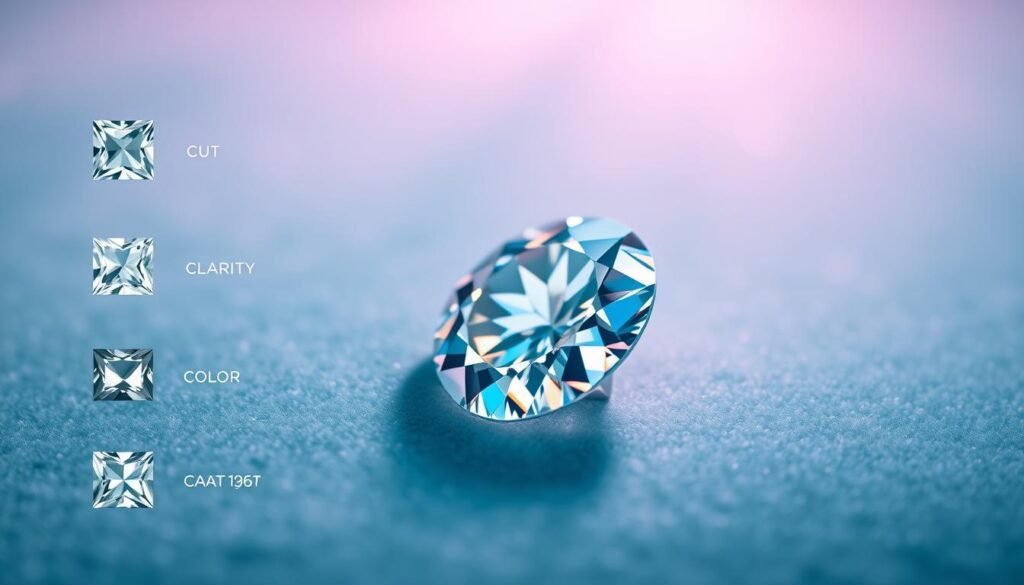
Investment Value and Resale Considerations
Diamonds are more than just beautiful stones; they can also be smart investments. Knowing what affects their value is key. Diamond certification is vital. It checks the quality using the 4 C’s: cut, color, clarity, and carat.
High-quality certified diamonds tend to keep their value or even grow it over time. This is because they have solid proof of their quality.
The diamond market changes due to many things. These include global demand, economic conditions, and jewelry trends. Keeping up with these changes helps you make smart buys and sales.
Storing and caring for your diamonds right also adds to their value. This makes them easier to sell later.
Buying diamonds for fun or as an investment requires understanding the market. Knowing about diamond certification and quality is essential. This way, you can make the most of your investment and enjoy a great experience.

Hi, I’m Jimmy, the founder of Brilliant Jewelry Guide. With years of experience and a passion for timeless jewelry, I’m here to help you find pieces that tell your story and celebrate life’s special moments.
Disclaimer: This article contains affiliate links, which means we may earn a small commission if you purchase through them, without any additional cost to you. The content on this website was developed with assistance from AI.
